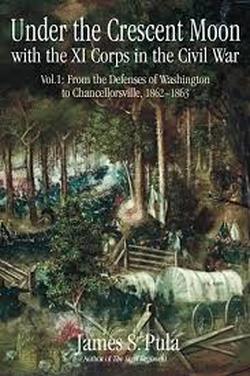
James S. Pula
Savas Beatie, 2017, 312 pp., $34.95
ISBN: 978-1-61121-337-9
Image courtesy of amazon.com
One of the facets of the American Civil War which people tend to gravitate towards is the immigrants who served in the army during the conflict. One of the nations which seems to get a great deal of attention for their service is Ireland, but according to research, the German nation brought more immigrants to armed service for the Union. However, in my reading, I have not yet found a book which signifies their service quite well. While Under the Crescent Moon talks more about the service of the Germans in the Civil War, it is a book surrounding the Eleventh Corps which was heavily German during its year in service.
James S. Pula is a professor at Purdue University Northwest. He has authored more than two dozen books including For Liberty and Justice: A Biography of Brig. Gen. Wlodzimierz B. Krzyzanowski, and The Sigel Regiment: A History of the 26th Wisconsin Volunteer Infantry 1862-1865. He is also the editor-in-chief of Gettysburg Magazine. He has received the Gambrinus Prize in History from the Milwaukee County Historical Society for his work on that book. He has also received honors from the Oskar Halecki Prize, the Rudewicz Medal, and the Officer’s Cross of the Order of Merit of the Republic of Poland.
The Eleventh Corps has largely been ignored through most of the writings of history due to the failures it gained throughout its career. However, Mr. Pula has brought us this book which not only outlines the year of service from this corps, but uses this format to speak on the enlistment and the makeup of the corps. As stated in the introduction, there were a great deal of German Immigrants who made up the corps and I often feel that the contributions of the German people during the Civil War are largely ignored. For that, I thank Mr. Pula for bringing this knowledge to the forefront. This book also throws away the myth that many within the Eleventh Corps were cowards due to them being at Jackson’s attack during the Battle of Chancellorsville. Instead, Pula brings us into the battle narrative and shows us what the corps completed after they were attacked that day. He shows us that while they may have been prey to the flank attack that they did not stop fighting. Sadly, the Eleventh Corps was the group which hefted the burden in the amazing chapter of this work called “There Must Be Scapegoats.”
I highly recommend this book not only to students of the Civil War in the East, but the Civil War in general. I have not yet come across a well written and researched book on the Eleventh Corps and I applaud James S. Pula for doing so. I do hope that with the release of the second volume that many of the myths and misstatements about the corps get put to rest. There were a great many deeds which these people accomplished and Pula has brought them to light. Accompanied by excellent maps and photographs, this is a book not to be missed.
 RSS Feed
RSS Feed
